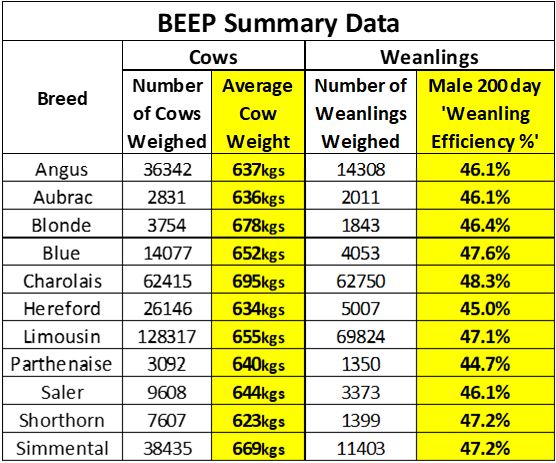Pat Donnellan, ICBF talks through some of the reasons why BEEP is worth its weight in gold.
‘Getting them all in to weigh will be some dose, are you home this weekend to help?’, ‘Well, have a guess, what weight do you think she is?’, ‘I can’t believe how heavy he is!’. All of these and many more like them could be heard on suckler farms the length and breadth of Ireland over the past 12 months as the BEEP (Beef Environmental Efficiency Pilot) scheme roared into action.
Huge numbers of cows and their calves were weighed on the same day in herds all around the country. Such naturally recorded on-farm maternal and growth type data, from a genetic improvement point of view is the hardest to record. However, it is pure gold in terms of its usefulness in helping us identify superior bloodlines for maternal and growth traits.
Different breeding programmes around the world would typically purchase daughters of AI bulls and run them in one group in a specific ‘station’ farm to find out which bull’s daughters are the best for milk and fertility. That’s fine however it can often happen that the daughters of a bull ranked number 1 in the ‘station’ environment don’t do as well out on-farm. This is because they are not being tested in the same environment that they will be asked to perform in. The BEEP scheme has allowed us to evaluate the daughters of AI bulls and Stockbulls in the exact same environment in which they will have to perform in i.e. on Irish farms. Also, obviously in terms of what it can tell us from an environmental point of view, the benefits of BEEP are huge.
Results
The BEEP scheme brought about the largest on-farm weighing campaign of beef cattle ever in Ireland. In total over 350,000 cows and the same number of weanlings have been weighed to date through the scheme. Following is a table showing some summary statistics from the scheme so far. Both commercial and pedigree animals are included in this table:

- The 7th of September 2019 was Ireland’s peak beef on-farm weighing day in the last year with 569 herds weighing 18,086 animals on that day.
- 72kgs is the range across all the main beef breeds in terms of ‘Cow Weight’.
- Shorthorn came out with the lightest average cow weight at 623kgs.
- Charolais came out with the best growth in weanlings with a ‘200 day weanling efficiency %’ of 48.3%
Don’t risk it
ICBF can tell from the sex, age, breed, number of calvings and ancestry etc of an animal if its weight is within normal biological expectations. In other words – is the weight guessed or not! The spread of weights across a group of animals is also looked at, i.e. It’s highly unusual that say a herd of 20 suckler cows of varying ages, breeds and backgrounds would all weigh within 5kgs of each other on the same day! There are statistical limits of probability around such data – in other words, how possible is it or not that this data is genuine or not. The thinking that putting in a really low weight on a cow will automatically turn it into a 5-star cow is also incorrect.
Any ‘dodgy’ data is then not used in the €uro-Star calculations for those animals and is excluded from breed statistics etc. It is crucial that the quality of data in the ICBF database is kept at an extremely high standard – otherwise the resulting €uro-Stars will be giving a false reading of how a bloodline is expected to perform. Only a very small % of data falls into this category of being unreliable. The vast majority of data was accurately recorded and as said earlier, is extremely valuable from a genetic progress and environmental viewpoint.
